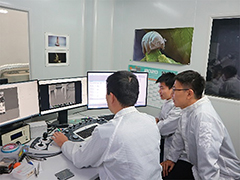Low-Dimensional Transport Research Unit
Principal Investigator
- PI Name
- Ding Zhang
- Degree
- Ph.D.
- Title
- Unit Leader
- Brief Resume
2014 PhD in physics, Max Planck Institute for Solid State Research, Stuttgart, Germany 2014 PhD in physics, University of Stuttgart, Stuttgart, Germany 2014 Post-doctor, Tsinghua University, Beijing, China 2016 Assistant Professor, Tsinghua University, Beijing, China 2018 Associate Professor, Tsinghua University, Beijing, China (-present) 2021 Unit Leader, Low-Dimensional Transport Research Unit, Cross-Divisional Materials Research Program, RIKEN Center for Emergent Matter Science (-present)

Outline

Our research unit studies a variety of low-dimensional electronic systems that undergo Cooper pairing. We aim at addressing some of the basic properties such as the pairing mechanism and the pairing symmetry. Furthermore, we look for novel quantum phenomena in reduced dimensions under specially designed conditions. The experimental knobs include stacking van der Waals heterostructures, injecting lithium/hydrogen ions, varying the magnetic field orientations at ultralow temperatures, and ramping up the magnetic field to an extremely high value. By collaborating closely with experimental and theoretical experts in the field, we hope to gain a comprehensive understanding of those exotic phenomena.
Research Fields
Physics
Keywords
Condensed matter physics
High-temperature superconductor
Josephson effect
Low dimensional superconductors
Van der Waals epitaxy
Results
Josephson tunneling in twisted bilayer cuprates
Superconductivity is one of the macroscopic quantum phenomena. The superconducting state can be described by quantum mechanical wave functions categorized as s-, p-, d-wave, etc., similar to the wave functions of a hydrogen atom. Conventional superconductors such as tin or aluminum host s-wave pairing symmetry, and although it remains debatable, most researchers believe that copper oxides are d-wave superconductors instead. Theoretically, if two d-wave superconductors are stacked vertically, the Josephson coupling strength starts to change once one superconductor is twisted against the other one. It monotonically drops to zero when the rotation angle increases up to 45 degrees. By contrast, the s-wave superconductors show constant Josephson coupling, irrespective of the rotation angles. Recently, we successfully fabricated high-quality c-axis twisted Josephson junctions with accurate control over the twist angle. Junctions at various twist angles all exhibit a single tunneling branch behavior, suggesting that only the first half of a unit cell on both sides of the twisted flakes is involved in the Josephson tunneling process. Interestingly, we found that when one cuprate flake is rotated by 45° against the other, Josephson coupling still exists, and the coupling strength of 45° and 0° are comparable. This behavior is consistent with s-wave pairing symmetry.
Type-II Ising pairing in few-layer stanene
In recent years, two-dimensional non-centrosymmetric superconductors show large in-plane upper critical fields, far exceeding the conventionally expected value. To explain this phenomenon, a so-called Ising pairing mechanism was proposed, in which the paired electrons stem from spin-split bands with the spin orientationslocked out-of-plane. Recently, we observed enhanced in-plane upper critical fieldin a highly symmetric material—few-layer stanene. This is based on our previous discovery of superconductivity in the same material. In the more recent work, we clearly observed an up-turn behavior of the critical magnetic field as the temperature approaches absolute zero. However, since stanene is centrosymmetric, the observed behaviors cannot be explained by the established theory of Ising superconductivity. We therefore proposed a new type of Ising pairing—type-II Ising paring—which results from the combination of spin-orbit coupling and high lattice symmetry of the materials. Ourwork provides strong evidence for the existence of Ising superconductivityand substantially broadens the scope for the realization of Ising superconductors.
Members
Ding Zhang |
Unit Leader | ding.zhang[at]riken.jp |
|---|
Publications
- H. Wang, Y. Zhu, Z. Bai, Z. Wang, S. Hu, H.-Y. Xie, X. Hu, J. Cui, M. Huang, J. Chen, Y. Ding, L. Zhao, X. Li, Q. Zhang, L. Gu, X. J. Zhou, J. Zhu, D. Zhang, and Q.-K. Xue
Nat. Commun. 14, 5201 (2023)Prominent Josephson tunneling between twisted single copper oxide planes of Bi2Sr2-xLaxCuO6+y
- M. Liao, Y. Zhu, S. Hu, R. Zhong, J. Schneeloch, G. Gu, D. Zhang, and Q.-K. Xue
Nat. Commun. 13, 1316 (2022)Little-Parks like oscillations in lightly doped cuprate superconductors
- M. H. Liao, H. Wang, Y. Y. Zhu, R. N. Shang, M. Rafique, L. X. Yang, H. Zhang, D. Zhang, and Q. K. Xue
Nat. Commun. 12, 5342 (2021)Coexistence of resistance oscillations and the anomalous metal phase in a lithium intercalated TiSe2 superconductor
- Y. Zhu, M. Liao, Q. Zhang, H.-Y. Xie, F. Meng, Y. Li, Z. Bai, S. Ji, J. Zhang, K. Jiang, R. Zhong, J. Schneeloch, G. Gu, L. Gu, X. Ma, D. Zhang and Q.-K. Xue
Phys. Rev. X 11, 031011 (2021)Presence of s-Wave Pairing in Josephson Junctions Made of Twisted Ultrathin Bi2Sr2CaCu2O8+x Flakes
- J. Falson, Y. Xu, M. Liao, Y. Zang, K. Zhu, C. Wang, Z. Zhang, H. Liu, W. Duan, K. He, H. Liu, J. H. Smet, D. Zhang, and Q.-K. Xue
Science 367, 1454 (2020)Type-II Ising pairing in few-layer stanene
Contact Us
E-mail:
ding.zhang[at]riken.jp


